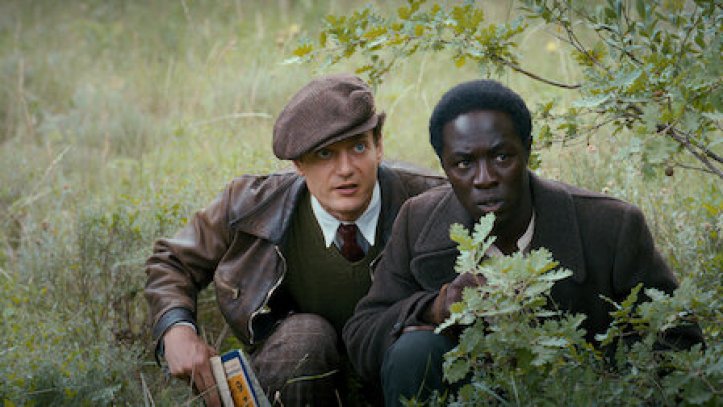
Review by C.J. Bunce
Where the other members of the cast of Community have pretty much continued to make their marks since the series ended, series co-lead Gillian Jacobs finally has seized a serious dramatic role worthy of her talent. Her character is a spiritual successor of sorts to Jacobs’ Community character Britta Perry, who thought of herself as the kind of real-life heroine she plays in Netflix’s new, limited, seven-part historical drama with a quirky twist, Transatlantic. From creators Daniel Hendler and Anna Winger, the series is a light companion of sorts to Herman Wouk’s Winds of War, a modern world take on love, loss, art, and intrigue from the perspective of Americans based in France during the early days of World War II, trying to sneak Jewish refugees, and many creative, political, and cultural icons, out of occupied France before the Nazis tightened their grip on the nation. The quirky bits of the series include interwoven French-infused period humor, black and white Surrealist credits and end credits, and a Wes Anderson meets the Coen Brothers’ Hail, Caesar vibe and the international conflict of The Bank Job. It may just be this year’s answer to The Offer and The Queen’s Gambit–a standout series that blends genres in a refreshing, new way.

The series is filled with real-life historical figures who are adapted melodrama-style as only historical fiction mini-series can do. Cory Michael Smith (Gotham) stars as Varian Fry, an American journalist who helped usher 2,000 refugees out of France in the year before the U.S. entered World War II, leading the American Emergency Rescue Committee in Marseilles. Smith co-stars with Community’s Gillian Jacobs, who plays Chicago heiress and ERC operative Mary Jayne Gold. Gold is the kind of heroine you want to stand and cheer on, with Jacobs blending a 1940s look with Rosie the Riveter grit. Lucas Englander is Albert Hirschman, a German Jewish refugee who helped others escape France over the mountains, who links up with Gold in this story. Deleila Piasko is Lisa Fittko, another figure instrumental in helping refugees get out of France. Law & Order: L.A. and Ant-Man’s Corey Stoll has his best character performance yet as a lackluster opportunistic American diplomat also connected with Gold’s refugee efforts. Ralph Amoussou rounds out the main cast as another composite character, a hotel concierge from Africa who starts his own spirited resistance movement. And there’s a dog named Risotto playing a dog named Dagobert who gets his own subplot (it’s good stuff).

But the real-life figures don’t end there. Moritz Bleibtreu (Run Lola Run) is Walter Benjamin, the German Jewish philosopher who committed suicide to evade being taken by the Nazis. Jonas Nay is German satirist Walter Mehring. The best casting is Piasko as Lisa Fittko and Alexa Karolinski as Hannah Arendt–ringers for the real life historical figures. Arendt would become one of the world’s best known historians.

The art world name-dropping cameos form much of the fun and surprise of the series, which stands in contrast to this horror story of the world on the precipice of the Holocaust, resulting in issues of tonal conflict the writing struggles to get right. Gera Sandler and Ronit Asheri play Marc and Bella Chagall. Alexander Fehling (Inglourious Basterds) is Surrealist artist Max Ernst. Hande Kodja is French painter and Surrealist Jacqueline Lamba. Louis-Do De Lencquesaing is Surrealist André Breton. But the most exciting surprise character cameo is renowned actress Jodhi May (The Last of the Mohicans) as Peggy Guggenheim of NYC museum fame, in France in this period gathering up then-Modern Art.
For its drama elements, the series covers sexism, racism, and the plight of homosexuals in the early 1940s, as well as American intransigence in acknowledging Nazi atrocities before the war directly arrived on its doorstep at Pearl Harbor. Classic war movie homages include escape and prison scenes out of Stalag 17 and The Great Escape. One episode is spent addressing living life to the fullest, something that feels like a tangent episode while also getting to the heart of everything. Keep an eye open for Dunkirk’s Luke Thompson as a diplomat in the American office who is the quiet hero of the whole story, and one of the writers.

Transatlantic is ambitious. It attempts to put too much together, probably too many big themes, while also trying to balance the weight of the most significant event in modern world history against its artsy style and haute culture name dropping a la James Lapine’s romantic comedy Impromptu. The French are portrayed somewhat like the bumbling stormtroopers of Star Wars, complete with a lead police inspector (played by Grégory Montel) who acts far too much like Pink Panther’s Inspector Clouseau. The romance is very 1980s mini-series stuff (that’s good if you’re nostalgic for that sort of thing), and visual antics and chicanery speak the language of melodrama (it’s in the same department, but it’s not trying to be Schindler’s List). Yet it’s also not a quasi-historical misfire with glitz like Mank. A half-hour documentary is available on Netflix about the making of Transatlantic, which highlights the intentions of the creators to balance all of the relevant interests in a respectful way, while adding local color (literally, as the series is filmed in the unique city of Marseilles), humor, style, romance, politics, history, and drama. For art history it would make an interesting double feature with The Monuments Men, which was about tracking down Nazi-seized art at the end of the war.
The series works on several levels so long as you don’t overthink it or misinterpret the series as straight history. It’s a refreshing approach to difficult subject matter with some great acting, characters, and period costumes. It’s a mix, but a good mix. And it’s the best casting so far this year and should be a triumph for Jacobs. Don’t miss Transatlantic, now streaming on Netflix.

